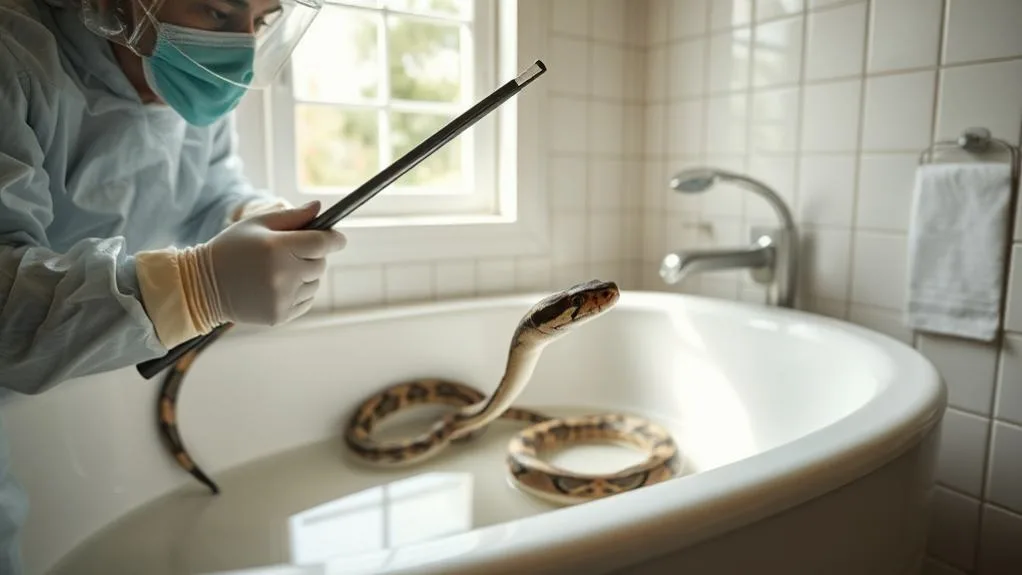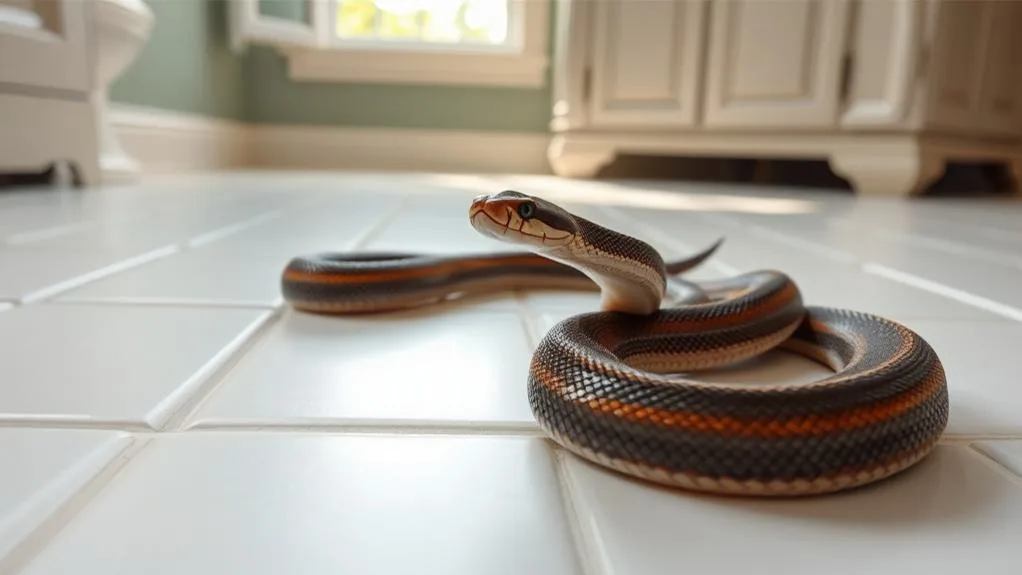If you spot a snake in your bathroom, don't panic – and definitely don't try to flush it! First, close the toilet lid and lock the bathroom door to contain it. Back away slowly and call professional pest control or animal services immediately. While waiting, snap a quick photo if it's safe – this helps with identification. Never attempt to handle the snake yourself, even if you think it's harmless. Common bathroom invaders like Garter Snakes and Rat Snakes enter through plumbing gaps and roof vents seeking moisture and prey. Let the pros handle removal while you stay safe and calm. There's a whole strategy to keeping these slithery surprises from becoming repeat visitors.
Immediate Steps for Snake Encounters
Table of Contents
A snake in your bathroom can be an unsettling discovery, but taking quick, deliberate action is essential. When you spot a snake in your toilet or anywhere in the bathroom, don't panic – though I know that's easier said than done!
Using professional snake tongs can help safely handle smaller snakes, but always exercise extreme caution.
Here's what you need to do immediately:
- Slam that toilet lid shut! You don't want your unwanted guest slithering away.
- Lock down the bathroom door to prevent the snake from entering other rooms.
- Keep your cool – no screaming or running around (save that for later).
Pro Tip: Never try to flush the snake down the toilet. Trust me, you'll only make things worse.
Next, make the right calls:
- Renters: Contact your landlord ASAP.
- Homeowners: Get pest control or animal control on the line.
- Everyone: Stay away from DIY snake wrestling.
Common Entry Points for Snakes

Sneaky serpents have multiple ways of turning your bathroom into their personal entrance hall. Let me break down exactly how these unwanted guests are getting VIP access to your private space.
Your ventilation pipes? They're basically a snake waterslide when they're not properly covered. I hate to break it to you, but snakes in toilets aren't just urban legends – they can swim up through damaged plumbing. (Yes, really.)
These dark, damp environments attract snakes seeking both shelter and temperature regulation, making bathrooms particularly appealing.
Here's where these reptilian visitors are sneaking in:
- Uncovered roof vents (their favorite skylight entrance)
- Cracks in your foundation or siding (snake-sized welcome mats)
- Gaps around plumbing fixtures
- Open windows and doors (obvious, but often overlooked)
- Overgrown vegetation near your house (their perfect cover)
*Pro tip: Check these entry points monthly. One missed crack could mean an unwanted bathroom buddy.*
Why Snakes Choose Bathrooms

Slithering into your personal space, snakes don't randomly choose bathrooms – they're drawn to specific features that make these rooms irresistible.
You might think your bathroom's just a place to handle business. But for snakes that enter your home, it's practically a five-star resort.
During winter months, snakes seeking winter shelter spots are especially drawn to warm indoor spaces like bathrooms. Since snakes are coldblooded, they're constantly searching for temperature-controlled environments. Your bathroom? It's perfect.
Here's what makes your bathroom their dream home:
- Cool, damp conditions create ideal resting spots
- Dark corners under sinks and cabinets offer sweet hiding places
- Your unwanted house guests (insects and mice) provide snacks
- Moisture-rich areas help them stay hydrated
- Plumbing gives them secret highways into your home
*Pro tip: Those peaceful, long showers you love? Yeah, they're creating a snake spa experience. Maybe keep the humidity down a notch.*
Safe Removal Techniques

Now that you understand why snakes choose your bathroom, let's focus on safe ways to remove these unexpected visitors. Trust me – your first instinct to panic and flush isn't the solution.
While natural snake deterrents like cedar oil and cinnamon can help prevent future visits, you'll need to deal with your current situation first.
Your immediate steps are essential:
- Close that toilet lid ASAP! You don't want your scaly friend going on a house tour.
- Resist the urge to flush. Seriously. It'll only make things worse by sending your serpentine visitor deeper into the plumbing.
- Got a broom? Perfect. Keep your distance and gently guide the snake toward an exit.
Pro tip: Don't play hero. Your best bet is calling professional pest control or animal control. They've got the tools and know-how to handle snake removal safely.
Document everything – yes, even take pictures. You'll want proof when telling this story later!
Prevention and Home Protection

The age-old saying "an ounce of prevention is worth a pound of cure" rings especially true when it comes to bathroom snake encounters.
Let's face it – nobody wants a surprise visitor while they're on the throne.
Your best defense against unwanted serpentine guests starts with these hardcore prevention measures. Similar to how eastern hognose snakes can squeeze through tight spaces in nature, these reptiles are masters at finding entry points into homes.
- Seal every exterior gap larger than 1/4 inch. Yes, every single one. Snakes are basically living noodles that can squeeze through tiny spaces.
- Install screens on all vents and ducts. Think of them as snake bouncers for your home.
- Get a multi-flap valve for your toilet waste pipe. Trust me, you don't want to know why this matters.
Pro Tip: Regular plumbing inspections aren't just for leaky pipes. They're your first line of defense against bathroom snake invasions.
Keep your yard tidy too – tall grass is basically a snake's version of a luxury hotel.
Signs of Snake Activity

Recognizing the signs of snake activity can mean the difference between early detection and an unwanted bathroom encounter.
I'm going to help you spot the warning signs before you're face-to-face with a scaly surprise.
Look for these key indicators:
- Shed skin under sinks or behind toilets (yeah, that's not just dusty paper)
- Unexplained gurgling sounds from drains that weren't there before
- Mystery droppings that don't match your usual suspects
- A sudden uptick in rodents or insects (snakes' favorite takeout menu)
Pro Tip: Check dark corners and hidden spaces weekly. Trust me, you'd rather find evidence of a snake than the actual snake while you're mid-shower.
If you spot any of these signs, don't play detective – call a professional immediately.
Your bathroom shouldn't feel like a wildlife documentary.
Professional Help and Costs

Once you've spotted signs of snake activity, reaching for your phone instead of your bathroom door handle is the smartest move you can make. Professional snake removal services aren't cheap, but they're a lot better than a trip to the ER. Trust me on this one.
| Service Type | Cost Range | Response Time | Safety Level |
|---|---|---|---|
| Standard Removal | $350-450 | 24-48 hrs | High |
| Emergency Service | $500-600 | 1-3 hrs | High |
| Prevention Install | $200-300 | Scheduled | Very High |
| Inspection Only | $100-150 | Same Day | Medium |
When hiring emergency pest control, always verify their snake handling credentials. The best companies will not only remove your unwanted bathroom guest but also implement prevention strategies to keep others from moving in.
*Pro Tip: Ask about their guarantee policy and post-removal inspection services. You'll want both.*
Local Snake Species Guide

Four main snake species call our local area home, and knowing which ones you might encounter in your bathroom can make a huge difference in how you respond.
Yes, these slithery friends can hold their breath and come right up through your pipes – fun times!
- Eastern Garter Snake: Your harmless water-loving friend who's probably just lost.
- Eastern Rat Snake: The climber who might've entered through your roof or windows.
- Copperhead: The venomous one with the hourglass pattern you definitely don't want to mess with.
- Black Racer: The speedster who's more scared of you than you're of it.
*Pro Tip: Of these four, only the Copperhead is venomous. If you spot those distinctive hourglass markings, back away slowly and call a professional.
Don't try to be a hero – your bathroom can wait!*
Frequently Asked Questions
How Do I Get Rid of Snakes in My Bathroom?
I'd call pest control specialists immediately to remove any snakes safely. Meanwhile, I'll keep my distance and avoid handling them. If needed, I can use a broom to guide them out gently.
How Common Is It for a Snake to Get in Your Toilet?
I'll tell you straight: finding a snake in your toilet is extremely rare. While it's possible through sewer systems, I'd say you're more likely to win a small lottery than encounter this slithery situation.
What Attracts Snakes to Toilet?
Like a cool oasis in a desert, I'll tell you that toilets lure snakes with their damp, cool environment. They're drawn to the moisture, hiding spots, and the potential prey like rodents and insects.
Can Snakes Come up the Toilet Drain?
Yes, I can confirm that snakes can swim up toilet drains through sewer systems and vent pipes. While it's rare, I've seen reports of snakes entering homes this way, particularly in warmer regions.
Last Word
Look, I won't sugarcoat it – finding a snake in your bathroom isn't exactly a spa day. You've now got all the tools to handle this slithery situation like a pro, not like your neighbor Bob who tried catching one with salad tongs. Remember: stay calm, call experts when needed, and seal those entry points. Or you could just move to Antarctica. I hear they're snake-free, though the bathroom situation's a bit chilly.








